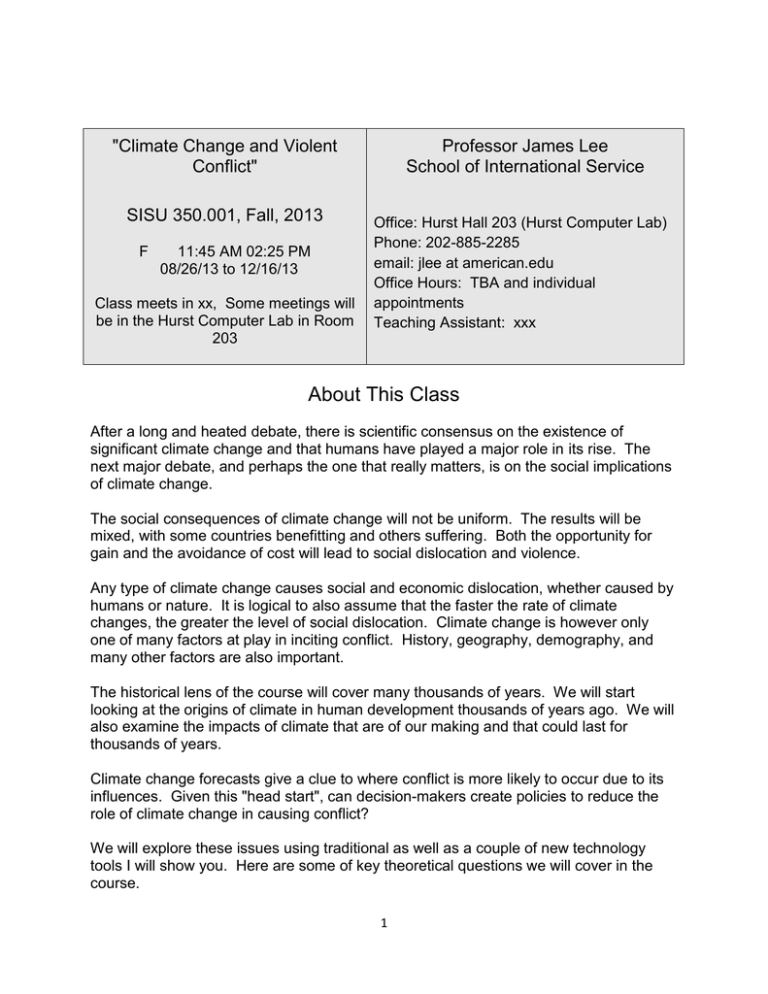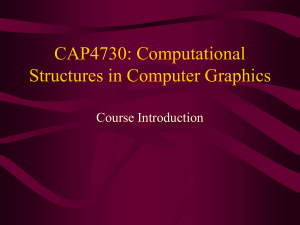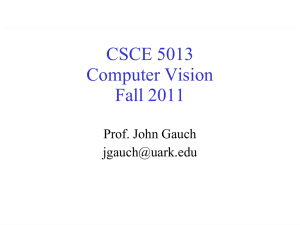Course Syllabus - Mandala Projects
advertisement

"Climate Change and Violent Conflict" SISU 350.001, Fall, 2013 F 11:45 AM 02:25 PM 08/26/13 to 12/16/13 Class meets in xx, Some meetings will be in the Hurst Computer Lab in Room 203 Professor James Lee School of International Service Office: Hurst Hall 203 (Hurst Computer Lab) Phone: 202-885-2285 email: jlee at american.edu Office Hours: TBA and individual appointments Teaching Assistant: xxx About This Class After a long and heated debate, there is scientific consensus on the existence of significant climate change and that humans have played a major role in its rise. The next major debate, and perhaps the one that really matters, is on the social implications of climate change. The social consequences of climate change will not be uniform. The results will be mixed, with some countries benefitting and others suffering. Both the opportunity for gain and the avoidance of cost will lead to social dislocation and violence. Any type of climate change causes social and economic dislocation, whether caused by humans or nature. It is logical to also assume that the faster the rate of climate changes, the greater the level of social dislocation. Climate change is however only one of many factors at play in inciting conflict. History, geography, demography, and many other factors are also important. The historical lens of the course will cover many thousands of years. We will start looking at the origins of climate in human development thousands of years ago. We will also examine the impacts of climate that are of our making and that could last for thousands of years. Climate change forecasts give a clue to where conflict is more likely to occur due to its influences. Given this "head start", can decision-makers create policies to reduce the role of climate change in causing conflict? We will explore these issues using traditional as well as a couple of new technology tools I will show you. Here are some of key theoretical questions we will cover in the course. 1 Summary of Goals and Outcomes for Climate Change and Armed Conflict Objective 4. Make Effective Use of Data Visualization Tools. 2. Make Effective Use of Data Visualization Tools. 2. Model a Multiplicity of Causes of Development and Conflict 4. Create Future Scenarios Explanation of Objective You will learn how to prepare visual images that can assist in understanding climate and other issues. This skill will be an asset in reaching the prior three goals noted. You will learn how to prepare visual images that can assist in understanding climate and other issues. This skill will be an asset in reaching the prior three goals noted. How, why, and where cases of climate change, development occur is of interest to the history. Relevant Assignment/Assessment You will learn to use Google Earth as a means for creating original graphics. Making good graphics however is rooted in some techniques and rules for making graphics. The general trajectory of climate over the next century is agreed, but there is less certainty to development and conflict. The future is not however a single projection or immune from our efforts to change it. You will prepare a regional analysis of climate change and conflict. The case study will include graphics including map visualization and causal diagramming. You will learn sources for future forecasts and techniques for estimating future possibilities. 2 You will learn to use Google Earth as a means for creating original graphics. Making good graphics however is rooted in some techniques and rules for making graphics. You will learn the technique of causal diagramming and how to create them. These methods are rooted in discussions of cases that illustrate how to mentally construct these complex models. Key Questions We Will Address 1. Climate change includes a wide variety of impacts that are environmental in nature. There are many types of environmental conflict, including climate change. Where does climate change stand within the larger field of environmental conflict? 2. Climate change alters resource availability. How do changing resources, through their degradation or their abundance, lead to conflict? How does it impact development? 3. Climate change will do more than raise the temperature. There will clearly be social implications, including conflict. Yet the cause and affect are indirect. What are the pathways from climate change to conflict? Development, or lack of it, can be a contributing cause of conflict. 4. Are there examples of policy approaches, and their limits, to ameliorating environmental or developmental conflict? What are the lessons learned? 5. What are some historical examples of how has climate change altered resource availability, development that eventually led to conflict? 6. What are trends in climate change and forecasts of future behavior? How does this break down on a regional basis? 7. What are some plausible future scenarios of climate change, development, and conflict? 8. What are the policy and perspectives that can mitigate or prevent climateinduced conflict? 9. What are the new and emerging topics in climate change, development, and conflict research? 3 Required Texts There are four required books for the course. They can be acquired through the AU bookstore or on-line vendors. All ISBN numbers are for paperbacks that will be for sale in the bookstore. Kindle versions are also available through other vendors. (1) Brian Fagan, The Great Warming: Climate Change and the Rise and Fall of Civilizations, 2009. (2) James R. Lee, Climate Change and Armed Conflict: Hot and Cold Wars, Routledge, 2009. ($39.95, paperback). ISBN-10: 9780415592512 (3) William F. Ruddiman, Plows, Plagues, and Petroleum: How Humans Took Control of Climate, Princeton, 2010, ($12.67, paperback). ISBN-10: 0691146349 (4) Laurence C. Smith, The World in 2050, Plume: New York, 2011($10.88, paperback). ISBN-10: 0452297478 Required Software (all free) WordPress: AU has a WordPress license you will be using. DIA: This program is used to draw causal diagrams and of use for a variety of other tasks including electrical engineering and computer system programming. http://dia-installer.de/ Google Earth: Mapping device that can save images for use in web pages. Can also edit map images. http://www.google.com/earth/index.html Picasa: Software for simple digital editing. Graphics can be edited using Picasa (as can a DIA image). http://picasa.google.com/ 4 Assignments and Grading Assign Points Due 1. Case Study Proposal 5 2. Causal Diagram 10 tba 10 tba 10 tba 3. History 4. Visual Map Description tba Provide a brief case study proposal. Create a graphic and write-up of a causal loop diagram Provide a history of the case study, weaving in a variety of key threads. Create a map and write-up for your case study. 5. Dream0 weaver Quiz tba Take a practice hands-on Dreamweaver programming quiz. Open book. 6. ICE Case 35 Study tba Provide a draft and post a case study for a virtual conference. 7. Future 25 Assessment tba Give a future assessment for a region of on climate and conflict influences. 8. Being There tba Participating in class activities, adding to discourse, providing a classroom presence. 5 Grade/Numerical Score Table: A 93-100 A- 90-92 B+ 87-89 B 83-86 B- 80-82 C+ 77-79 C 73-76 C- 70-72 D+ 67-69 D 64-66 D- 60-63 F 0-59 Grade: A-F (100 point scale) Grading Rubric ___25___ Analysis: Coverage of critical theoretical issues, use of course tools in coverage. ___25___ Concepts and Writing: Structure, clarity of expression, coverage of issues. ___25___ Sufficiency: Completeness of assignment (formats, gaps, research, presentation). ___25___ Brilliance: Creativity in methods and theories, and data visualization. ___100___ Total 5 Blackboard Course Layout BB Site Materials Descriptions Course, Name, semester and number Course information contains the syllabus and course weekto-week planner. All assignments submitted here and discussions undertaken. I will post Lecture Notes. Causal Loops and Data Visualization folders contain a lot of relevant material for each assignment. Web Pages contain information of Dreamweaver and posting cases online. The Virtual Conference is used later, and the other features could be used. 6 Key University Contacts and Information AU Academic Integrity Code All students are governed by American University's Academic Integrity Code. The Academic Integrity Code details specific violations of ethical conduct that relate to academic integrity. By registering, you have acknowledged your awareness of the Academic Integrity Code, and you are obliged to become familiar with your rights and responsibilities as defined by the code. All of your work (whether oral or written) in this class is governed by the provisions of the Academic Integrity Code. Academic violations include but are not limited to: plagiarism, inappropriate collaboration, dishonesty in examinations whether in class or take-home, dishonesty in papers, work done for one course and submitted to another, deliberate falsification of data, interference with other students' work, and copyright violations. The adjudication process and possible penalties are listed in American University's Academic Integrity Code booklet, which is also available on the American University web site. Being a member of this academic community entitles each of us to a wide degree of freedom and the pursuit of scholarly interests; with that freedom, however, comes a responsibility to uphold the high ethical standards of scholarly conduct. Plagiarism: Academic Regulations (80.00.00 Academic Integrity Code) Plagiarism is the representation of someone else’s words, ideas, or work as one’s own without attribution. Plagiarism may involve using someone else’s wording without using quotation marks—a distinctive name, a phrase, a sentence, or an entire passage or essay. Misrepresenting sources is another form of plagiarism. The issue of plagiarism applies to any type of work, including exams, papers, or other writing, computer programs, art, music, photography, video, and other media. More information can be found at: http://www.american.edu/provost/registrar/regulations/reg80.cfm My Note on Use of Graphics You own the ideas and their representations in the Web pages you create. Make sure that you have the right to use the graphic files you send me to post on the Web (and of course, any words you copy). I have to act as a legal Internet Service Provider in this regard and follow the law on copyright protection. You are liable for any infringement claims. You cannot take any materials that are copyrighted or otherwise protected without permission. There are many places to obtain free graphics and you can make your own 7 (or your friends in faraway places can take pictures and send them to you). Usually you can ask permission to use graphics and often all that is required is to express thanks to the author and acknowledge ownership. Be sure that you have complete ownership of the product, because you are liable in cases of copyright infringement. I want you to provide me a bibliography of all the graphics files used attesting to the rights of usage, just as you do for published works you cite. Emergency Preparedness In the event of a declared pandemic (influenza or other communicable disease), American University will implement a plan for meeting the needs of all members of the university community. Should the university be required to close for a period of time, we are committed to ensuring that all aspects of our educational programs will be delivered to our students. These may include altering and extending the duration of the traditional term schedule to complete essential instruction in the traditional format and/or use of distance instructional methods. Specific strategies will vary from class to class, depending on the format of the course and the timing of the emergency. Faculty will communicate class-specific information to students via AU e-mail and Blackboard, while students must inform their faculty immediately of any absence due to illness. Students are responsible for checking their AU e-mail regularly and keeping themselves informed of emergencies. In the event of a declared pandemic or other emergency, students should refer to the AU Web site (www. prepared. american.edu) and the AU information line at (202) 885-1100 for general university-wide information, as well as contact their faculty and/or respective dean’s office for course and school/ college-specific information. Disabilities If you have difficulty in this course for any reason, please don’t hesitate to consult with me. In addition to the resources of the department, a wide range of services is available to support you in your efforts to meet the course requirements. Academic Support Center (x3360, MGC 243) offers study skills workshops, individual instruction, tutor referrals, and services for students with learning disabilities. Writing support is available in the ASC Writing Lab or in the Writing Center, Battelle 228. Counseling Center (x3500, MGC 214) offers counseling and consultations regarding personal concerns, self-help information, and connections to off-campus mental health resources. Disability Support Services (x3315, MGC 206) offers technical and practical support and assistance with accommodations for students with physical, medical, or psychological disabilities. If you qualify for accommodations because of a disability, please notify me in a timely manner with a letter from the Academic Support Center or Disability Support Services so that we can make arrangements to address your needs. 8 Blackboard and Wimba Help: blackboard@american.edu or 202.885.3904. Contact them for issues of BB or Wimba. If you are on campus, they are located in the Library, third floor. OIT Help Desk: help@american.edu General information technology and computer account questions. Student Evaluation of Teaching: Near the end of the course, you will have the opportunity to evaluate this online class and your learning experience by completing an online Student Evaluation of Teaching. The evaluation contains the same set of questions used in assessing classroom-based courses, with the addition of four questions specifically applicable to online learning. As with any other face-to-face course, you are strongly encouraged to participate in this evaluation of your educational experience. A high participation rate is critical to AU’s ability to continually improve and strengthen the quality of the University’s learning opportunities. 9






